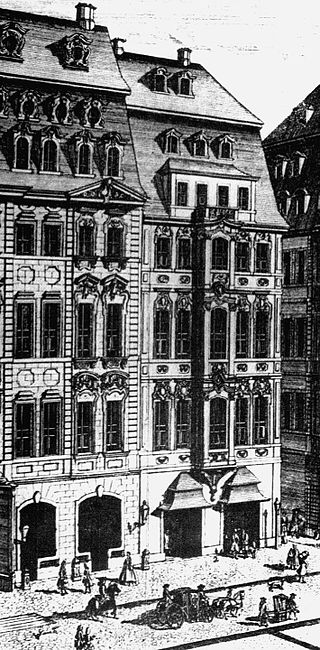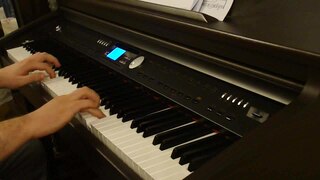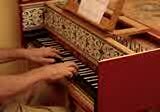Johann Sebastian Bach (1685–1750) was a German composer of the Baroque period.

Wolfgang Schmieder was a German music librarian and musicologist.

Schweigt stille, plaudert nicht, BWV 211, also known as the Coffee Cantata, is a secular cantata by Johann Sebastian Bach. He composed it probably between 1732 and 1735. Although classified as a cantata, it is essentially a miniature comic opera. In a satirical commentary, the cantata amusingly tells of an addiction to coffee.

The Minuets in G major and G minor, BWV Anh. 114 and 115, are a pair of movements from a suite for harpsichord by Christian Petzold, which, through their appearance in the 1725 Notebook for Anna Magdalena Bach, used to be attributed to Johann Sebastian Bach. These minuets, which are suitable for beginners on the piano, are among the best known pieces of music literature. The 1965 pop song "A Lover's Concerto", of which millions of copies were sold, is based on the first of these Minuets.
Das ist je gewißlich wahr, TWV 1:183, is a cantata by Georg Philipp Telemann. Due to an erroneous attribution to Johann Sebastian Bach, it appears in the Bach-Werke-Verzeichnis (BWV) as No. 141, but was moved to Anhang III, the Appendix of spurious works, in the 1990s second edition of that catalogue.
Ich weiß, daß mein Erlöser lebt, TWV 1:877, BWV 160, is a church cantata composed around 1725 by Georg Philipp Telemann for Easter Sunday, formerly attributed to Johann Sebastian Bach.
Schleicht, spielende Wellen, BWV 206, is a secular cantata composed by Johann Sebastian Bach in Leipzig and first performed on 7 October 1736.
Gedenke, Herr, wie es uns gehet, BWV 217, is a church cantata, formerly attributed to Johann Sebastian Bach. It is now attributed to Johann Christoph Altnickol, Bach's son-in-law.
Wer sucht die Pracht, wer wünscht den Glanz, BWV 221, is a cantata by an unknown composer, formerly attributed to Johann Sebastian Bach. The event for which it was written is also unknown.
Johann Georg Albinus was a German Protestant pastor and hymnwriter. He studied at the University of Leipzig and served as a rector at the Naumburg Cathedral School and the pastor of St. Othmar's Church, both in Naumburg. His hymns have been set by various composers, for instance by Johann Rosenmüller who set his hymn "Welt, ade! Ich bin dein müde" for SSATB voices, a setting which was adopted by Johann Sebastian Bach as last movement of his cantata Wer weiß, wie nahe mir mein Ende? BWV 27 (1726). Also Bach's cantata Der Friede sei mit dir, BWV 158 contains a stanza of this hymn, set to Rosenmüller's hymn tune.
The Orchestral Suite in G minor, BWV 1070 is a work by an unknown composer. It is part of the Bach-Werke-Verzeichnis catalogue of the works of J. S. Bach, and sometimes called the "Orchestral Suite No. 5", but was almost certainly not composed by him. It is more likely that the composer was his son W. F. Bach. It is a French suite with an overture and several dances, which has a similar structure to the 4 orchestral suites known to have been written by J. S. Bach. Evidence for its not being by the older composer includes the form of the opening movement, which differs from that used in the suites known to be by him, and the fact that the third movement is in a different key to the rest of the work, whereas J. S. Bach's suites are homotonal.

BWV Anh., abbreviation of Bach-Werke-Verzeichnis Anhang, is a list of lost, doubtful, and spurious compositions by, or once attributed to, Johann Sebastian Bach.
The Concerto, BWV 525a, is a trio sonata in C major for violin, cello and basso continuo, based on material otherwise found in Johann Sebastian Bach's first Organ Sonata, BWV 525, and Flute Sonata in A major, BWV 1032. The oldest extant manuscript containing the BWV 525a arrangement, D-B Mus.ms. Bach St 345, is dated to the middle of the 18th century. Although this version of Bach's sonata movements may have originated during his lifetime in the circle around him, it seems unlikely that the composer supervised, or even ordered, the manufacture of the string trio adaptation, thus the arrangement has been listed in BWV Anh. II, that is the Anhang (Anh.) of doubtful works, in the 1998 edition of the Bach-Werke-Verzeichnis (BWV). Breitkopf & Härtel published BWV 525a in 1965. Digital facsimiles of 18th- and 19th-century manuscript copies of the arrangement, in which the sonata is titled "Concerto", became available in the 21st century.

Twelve Little Preludes, BWV 924–930, 939–942 and 999, is a 19th-century compilation of short pieces, collected from various 18th-century manuscripts written by Johann Sebastian Bach and others. Notwithstanding their diverse origin and characteristics, they were published as a set of twelve keyboard preludes by Bach in, amongst others, the 36th volume of the Bach-Gesellschaft Ausgabe (BGA).
Prelude and Fugue in E minor, BWV 855, is the 10th prelude and fugue for keyboard (harpsichord) in the first book of The Well Tempered Clavier, composed in 1722 by Johann Sebastian Bach. The Prelude in E minor, BWV 855a, features as No. 18 ("Praeludium 5") in the 1720 Klavierbüchlein für Wilhelm Friedemann Bach. BWV 855a may also refer to both this Prelude and a Fughetta in the same key, an early version of BWV 855. Alexander Siloti made a piano arrangement in B minor of the Prelude BWV 855a.
Anhang, often abbreviated as Anh., refers to sections in publications such as the Bach-Werke-Verzeichnis (BWV), the Köchel catalogue (KV), or the Deutsch catalogue (D):
Fantasia and Fugue may refer to several compositions attributed mainly to Johann Sebastian Bach:




